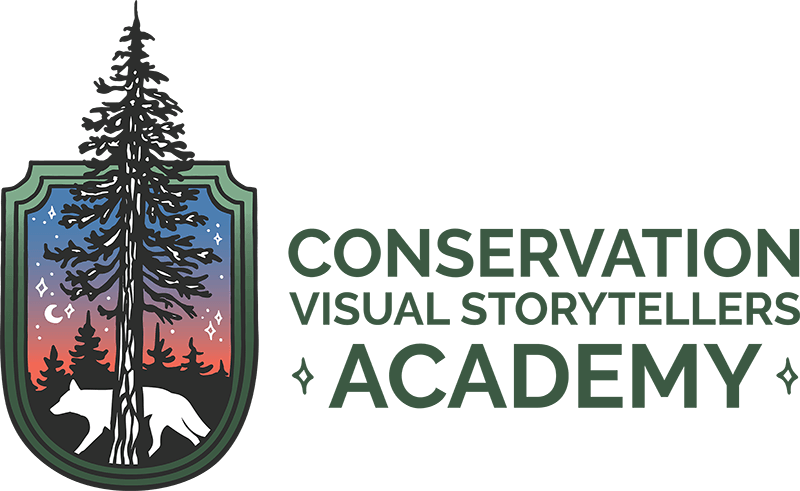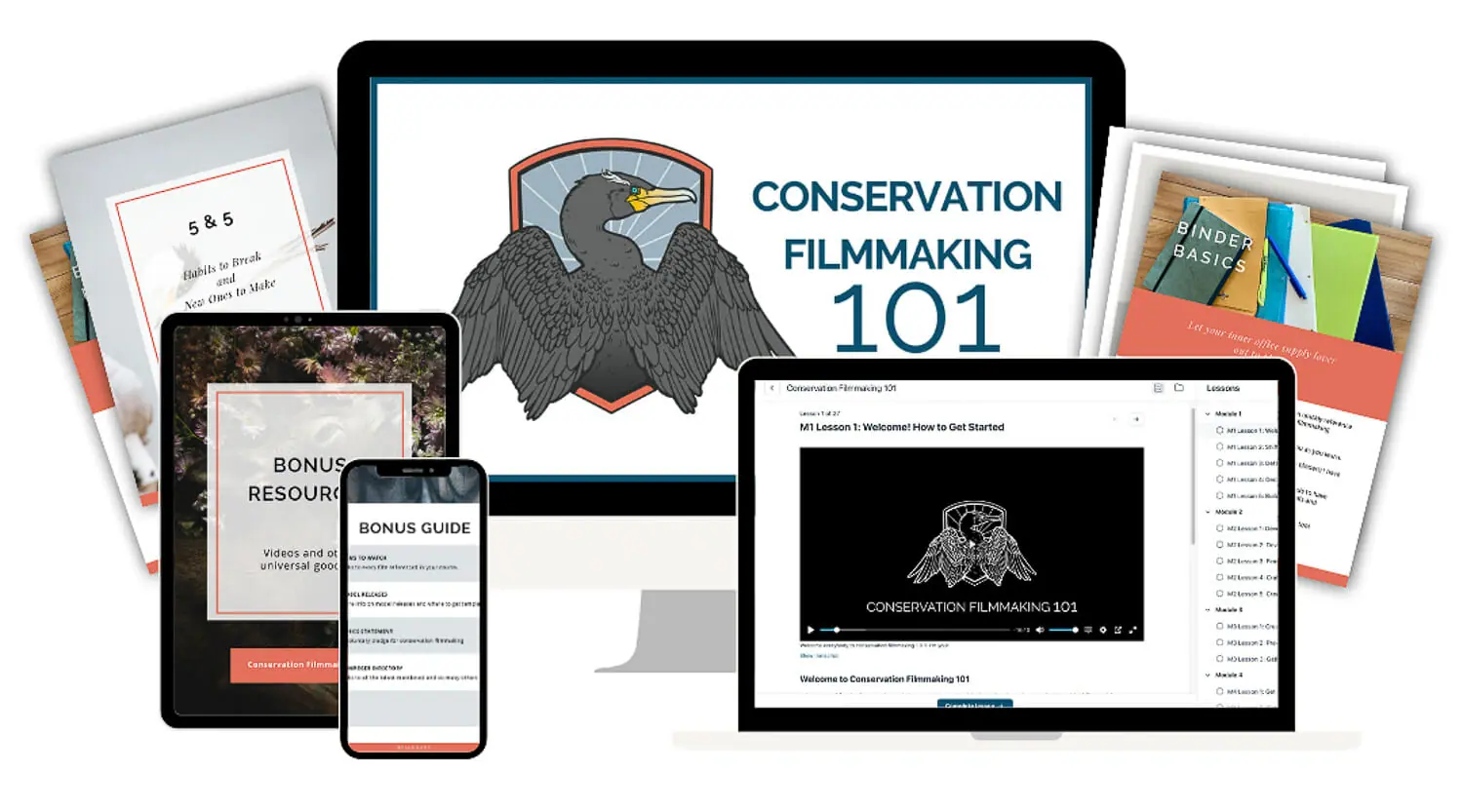Read Time: 6 minutes
When we see a gorgeous photo highlighting the natural world, it’s easy to sit back and appreciate the beauty in the image. But, as photographers interested in making an impact, we need to take viewers beyond that.
There’s a field of photography that goes a step further – by turns showcasing the planet’s splendor and telling the complex stories of the earth and its future.
The difference between the two fields
Conservation photography is a specialized form of nature photography that aims to capture images that bring attention to environmental issues, create awareness and motivate action.
Unlike traditional nature photography, which often focuses on beautiful landscapes, portraits of wild animals, or interesting wildlife behaviors, conservation photos are often filled with emotion, telling stories and going behind the scenes of ideas and issues.
That said, effective conservation photos can indeed be portraits of wildlife or naturescapes. That’s because it’s not just about what’s in the photos but what you do with the photos you make.
Conservation photography uses traditional nature photography as one tool in its expansive toolbox to educate, build awareness, and inspire audiences about environmental issues.
While we can’t deny our love and appreciation for traditional nature and wildlife photography, what we aim to do as conservation photographers is use our skills to inspire the sort of action that protects and preserves the natural world.
Now that we know how this particular niche differs from nature photography let’s look more deeply at what it’s all about.
In a long-term project called Urban Coyote Initiative, I created images that leaned into different styles – from fine-art portraiture to photojournalistic storytelling. The conservation impact didn’t depend on the style used, but rather the way the images were used to bring attention, awareness, and understanding to urban coyotes and coexistence.
Conservation photography isn’t a style – it’s a statement
Conservation photography is not a particular style but a powerful approach that uses visual storytelling to create an emotional connection between the audience and the environment. It uses photography and visual storytelling to raise awareness of environmental issues, foster understanding of complex problems, and motivate people to take action.
Though it’s often thought that conservation photography is exclusively photojournalistic in style, it can actually be anything from traditional documentary-style photography to methods that employ more artistic or abstract techniques, pulling in various elements and unique ideas.
It is not limited to one style or method, nor by how and where the work is published or presented; rather, its defining trait lies in the intent behind the work.
Conservation photography is about what you do with your images to make an impact, not the style of your photography.
You can be a fashion photographer, an epic landscape photographer, a commercial photographer, a wildlife photographer…
You can focus on fine art or large-format film or aerials…
Whatever your photographic approach, you are a conservation photographer when you put your images to work for the conservation causes you care about.
Conservation photography doesn’t have to be complicated – it can take on any style and still make a powerful statement. Showing the beauty of nature can engage mainstream audiences with the important message of conservation.
Conservation photography is for mainstream audiences
With such a critical need for action on environmental issues, we need to take an all-hands-on-deck approach to spread the messages, expanding into spaces not typically considered.
While we often think of conservation photography in connection with nature enthusiasts and environmentalists, it goes far beyond this as it addresses big-picture issues that affect everyone.
Yes, conservation photography covers things like endangered species, climate change, national parks, and protected areas. But it also covers things like economics, social justice, global trade, community building, and so much more.
So, conservation photo stories can easily fit within mainstream media outlets, helping issues to get beyond the choir.
While nature-focused publications are often the first to come to mind as a home for conservation photo stories, they’re just one of many, many possible ways to get your work into the world and make an impact.
What sets conservation photography apart from nature photography is the purpose behind the work, what the photographer does with the photos, and the actions that the photos inspire. And that means limitless possibilities for where your images can show up.
A photo story about the recovery of Channel Island foxes from the Endangered Species list appeals to many audiences depending on how it is framed – from scientific journals to travel magazines.
5 Examples of using photography for conservation impact
To maximize our impact, we need to get the right image in front of the right audience at the right time. Strategizing is crucial. This involves selecting the right mediums to showcase your images.
Examples of what that could look like are:
1. Instagram posts with informative captions
Social media is an excellent platform for impactful photography. Instagram, for example, is a powerful tool to promote conservation with multiple ways to share visuals.
You can create posts that include one or a few images with informative captions, or create stories, reels, or short videos using your photos with music and text explaining the environmental challenges highlighted imagery.
Remember to tag interested individuals and organizations, and use relevant hashtags to make your content more discoverable. This is also an opportunity to identify decision-makers and direct your audience on how to connect with them.
2. Camera club presentations that highlight conservation issues
Camera clubs invite speakers to present at meetings. Now with many clubs welcoming speakers to present virtually on platforms like Zoom, you can speak to clubs across the country or world about conservation stories or projects you’re working on and spread awareness to fellow photographers.
You can incorporate videos, animations, interactive tools, and other multimedia elements to make presentations more engaging and dynamic for the audience.
Camera clubs also organize photo contests and challenges, which are great opportunities to enter and share your work. Additionally, camera clubs often connect with other environmental organizations to amplify their message, and you can help spearhead one of these collaborations.
3. Gallery exhibits around a local conservation topic
Gallery exhibits can increase awareness within the community, inspiring creativity and innovation among local artists that help bring new perspectives and ideas while raising funds to support conservation efforts.
By combining the power of art and conservation, these exhibits inspire people to act and positively impact the environment.
Photos are wonderful fundraising tools. For example, a calendar fundraiser I ran for four years raised more than $20,000 for a conservation group. Learn more in this chapter of our guide.
4. Fundraisers for conservation organizations
Beyond exhibits, you can create your own fundraiser for a conservation organization using your photography as a money-raising tool. You can donate your images to an organization to use in their existing promotional materials or fundraising campaigns, or help design and run a campaign for them.
Another option is to auction prints of your images, with the proceeds going to support conservation efforts. Ensure you have clear agreements with the organization about how your pictures will be used.
5. Photo stories that inform and inspire
A powerful tool for visual storytelling, allowing for both creativity and effective communication of ideas and emotions, photo stories can be published in various places, including social media platforms, newspapers, magazines, galleries, exhibits, personal websites, or blogs.
Photo stories provide an engaging avenue for advocacy groups raising awareness about issues and promoting their causes.
Storytelling images can be used by organizations to rally support for an issue. This image of a Laysan albatross chick near marine debris has been used in online articles about plastic pollution.
Effective conservation photography starts with your WHY
Conservation photography doesn’t require you to sign up with National Geographic, pack a bag, and head off to a foreign land.
It starts at home, and it starts with your why.
There’s a reason you want to be a conservation photographer. So… why are you doing this work?
This is not an easy question to consider, but when you find your answer, it becomes a lifeline in the toughest times.
Your answer to this question becomes a guiding light for everything else you do. It gives you purpose and focus, and the courage to persevere when things get hard.
It helps you to stay aligned with your values and lets you know when you are veering off course.
Your WHY is what takes your photography beyond nature photography and into the realm of conservation photography, where you use your images to make an impact.
Effective conservation photography can be something as seemingly small-scale as a community member sharing their photos of a natural area being disrupted by development, or as large-scale as Margot Ragget’s Remembering Wildlife books using work from Wildlife Photographers United to highlight the plight of elephants, rhinos, great apes, wild dogs, bears, cheetahs, and lions.
In each instance, the photos were taken and shared with an eye towards not only increasing public awareness of an issue, but with the intent to inspire action.
When the “why” behind your work drives you to put your images to use for positive change for the planet on any scale, you are a conservation photographer.
Conservation photography is an essential and evolving form of visual storytelling that has the potential to create a profound and lasting impact long after the photo has been captured, inspiring viewers to care for the environment and take action to protect it.
It’s as simple as that, really.
And if you’re fired up to use your photos to make an impact, then in our next article, we’ll help you figure out how to get started in the field.













